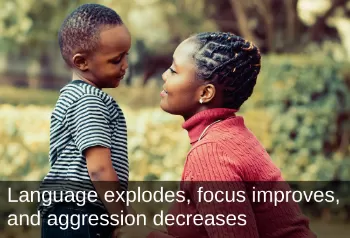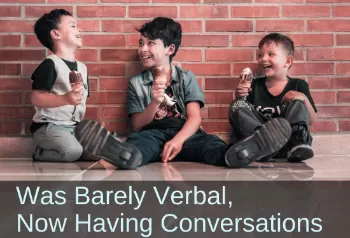Speech Challenges
3 Reasons Neurodevelopmental Movements Can Help with Speech Challenges
by Sonia Story, M.S. SLPs can earn CEUs
SLPs can earn CEUs
When working with challenged children as part of his psychiatry practice, Harald Blomberg, MD often observed that the innate rhythmic movements were helpful for stimulating and improving speech. Parents and therapists report the same observation in these case studies.
Here are three reasons why neurodevelopmental movements may promote speech
 Speech & Language Pathologist helps boy with speech and behavior
Speech & Language Pathologist helps boy with speech and behavior
- Natural Development: Human beings are designed to automatically learn speech in the process of maturing from infant to toddler. The innate neurodevelopmental movements of infancy play a large role in this process. Infant motor skills are associated with speech acquisition (Iverson, 2010), so it makes sense that neurodevelopmental movements promote speech and language in the process of natural infant development.
- Maturation of the Cerebellum: Blomberg reasoned that improved speech happened in large part because the rhythmic movements were stimulating and maturing the cerebellum. A mature celebellum has direct nerve links to the speech centers in the brain's cortex.
- Mature Brainstem/Muscle Tone: Another reason neurodevelopmental movements promote speech is that they mature the brainstem. The brainstem must be mature in order to develop and regulate muscle tone. With proper muscle tone, the muscles of the mouth and tongue are more able to make the sounds required for speech. Blomberg also taught that a mature brainstem helps with focus and communication by sending sensory information to the cortex where the language centers are located.
Corresponding with Blomberg's observations, Iverson (2010) found that rhythmical movements during infancy were associated with bursts in speech development.
What happens when neurodevelopmental movements are lacking?
When infant movements are lacking it often results in retained primitive reflexes. Retained primitive reflexes have been associated with developmental language disorders (Matuszkiewicz & Gałkowski, 2021).
Other researchers found that individuals with atypical rhythm were at higher risk for developmental speech and language disorders (Ladányi et al., 2020).
Can neurodevelopmental movements work beyond infancy to promote speech? 
The exciting thing about neurodevelopmental movements is that they appear to be effective for helping with speech—and many other challenges—regardless of the individual's age. Most likely this is because the brain is designed to recognize and respond to these movements with an impulse to promote further development—including speech.
Neurodevelopmental movements appear to help unlock speech, including in cases of selective mutism, while also facilitating other positive changes in physical, social, emotional, and cognitive functioning. See massive transformation in multiple realms after this 4 year old boy receives innate rhythmic movements and reflex integration from the Brain and Sensory Foundations course.
Also, check out this dedicated info-page for SLP professionals.
References
Iverson, J. M. (2010). Developing language in a developing body: The relationship between motor development and language development. Journal of Child Language, 37(2), 229-261.
Ladányi, E., Persici, V., Fiveash, A., Tillmann, B., & Gordon, R. L. (2020). Is atypical rhythm a risk factor for developmental speech and language disorders? Wiley Interdisciplinary Reviews: Cognitive Science, 11(5), e1528.
Matuszkiewicz, M., & Gałkowski, T. (2021). Developmental language disorder and uninhibited primitive reflexes in young children. Journal of Speech, Language, and Hearing Research, 64(3), 935–948.
Sonia Story, M.S. has been teaching neurodevelopmental movements since 2006.
Sonia developed the Brain and Sensory Foundations program to provide comprehensive training in neurodevelopmental movements—combining innate rhythmic movements, play, primitive reflexes, and postural reflexes.
She earned a Bachelor's degree in biology/psychology and a Master’s degree in Movement Sciences. She is the author of The Importance of Reflex Integration and the Evidence eBook, giving the rationale and evidence basis for using neurodevelopmental movements for helping with challenges such as ADHD, Sensory Processing Disorders, anxiety, emotional dysregulation, visual skill deficits, poor social skills, gross and fine motor delays and other neurodevelopmental and behavioral disorders.
Her work is featured in numerous podcasts, summits, and conferences, and in the books Almost Autism: Recovering Children from Sensory Processing Disorder; Special Ed Mom Survival Guide; Family Health Revolution; and Same Journey, Different Paths—Stories of Auditory Processing Disorder.
Sonia’s mission is to help children and families experience the profound benefits of neurodevelopmental and integrative movements for more functional and fulfilling lives.


